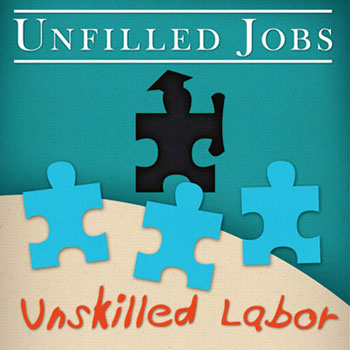Unfilled Jobs, Unskilled Labor
3,700,000 jobs won’t get filled unless we become skilled.
With a 7.3% unemployment rate, 11.6 million people are trying to fill 3.7 million jobs.
That’s 3 people trying to fill 1 job.
If all these jobs were filled, our unemployment rate would be just under 5% (4.97%)
Why are there still 3.7 million open, and unfilled jobs?
Jobs require more education than before.
Percentage of jobs requiring post-secondary education by year
1973: 28%
1992: 56%
2007: 59%
2010: 59%
2018: 62%
2020: 65%
But we’re not producing enough postsecondary educated workers.
We’re creating 300,000 too few postsecondary workers a year to keep up with demand.
2009:-300,000
2010:-600,000
2011:-900,000
2012:-1,200,000
2013:-1,500,000
2014:-1,800,000
2015:-2,100,000
2016:-2,400,000
2017:-2,700,000
2018:-3,000,000
By 2018, we’ll be 3 million postsecondary educated workers short of new demand.
The problem is accelerating
With job growth occurring in areas needing more education.
Industries with high post secondary requirements are growing the fastest
(but they are still the smallest) • [2008/2018/difference]
PSD percent # of jobs % of all jobs
Healthcare Professional and Technical 93% / 95% +2% 7.4mil / 8.8mil +1.4mil 5% / 5.5% +0.5%
Education 93% / 93% +0% 9mil / 10.2mil +1.2mil 6.1% / 6.3% +0.2
STEM 90% / 91% +1% 7.3mil / 8.6mil +1.3mil 5% / 5.3% +0.3
Community Services and Arts 89% / 91% +2% 4.6mil / 5.2mil +0.6mil 3.1% / 3.2 +0.1
Managerial and Professional Office 83% / 87% +4% 16.2mil / 17.7mil +1.5mil 11% / 11% +0
Industries with low post secondary requirements are growing the slowest
(but they are the biggest) • [2008/2018/difference]
PSD percent # of jobs % of all jobs
Sales and Office Support 62% / 65% +3 40.5mil / 43.5mil +3mil 27.5% / 27% -0.5
Healthcare Support 53% / 59% +6 3.9mil / 4.8mil +0.9mil 2.6% / 3% +0.4
Food and Personal Services 41% / 44% +3 24.6mil / 28mil +3.4 16.7% / 17.3% +0.6
Blue Collar 34% / 35% +1 33.8mil / 34.66mil +0.86 23% / 21.4% -1.6
Unfilled Jobs by Industry – 2013
July 2013 % of unfilled jobs
Construction 100,000 2.7
Manufacturing 237,000 6.4
Government 405,000 11.0
Leisure and hospitality 496,000 13.4
Professional and business services 569,000 15.4
mining/logging/information/financial activities/and other services 584,000 15.8
Education and health services 636,000 17.2
Trade, transportation, and utilities 662,000 17.9
Total 3,689,000 100
The South is lagging the farthest behind
The South has the lowest percentage of jobs requiring post secondary education…[5]
AND the highest percentage of unfilled jobs by region…[3]
Region #unfilled jobs % of all unfilled jobs Ave % of jobs requiring PSE
South 1400,000 38% 57.3%
Alabama(AL55%), Arkansas(AR52%), Delaware(DE59%), District of Columbia(DC71%), Florida(FL59%), Georgia(GA58%), Ken
–
tucky(KY54%), Louisiana(LA51%), Maryland(MD66%), Mississippi(MS54%), North Carolina(NC59%), Oklahoma(OK57%), South Caro
–
lina(SC56%), Tennessee(TN54%), Texas(TX56%), Virginia(VA64%), West Virginia(WV49%)
Midwest 857,000 23.2% 62.7%
Illinois(IL64%), Indiana(IN55%), Iowa(IA62%), Kansas(KS64%), Michigan(MI62%), Minnesota(MN70%), Missouri(MO59%), Nebras
–
ka(NE66%), North Dakota(ND70%), Ohio(OH57%), South Dakota(SD62%), Wisconsin(WI61%)
West 821,000 22.2% 62.4%
Alaska(AK63%), Arizona(AZ61%), California(CA61%), Colorado(CO67%), Hawaii(HI65%), Idaho(ID61%), Montana(MT62%), Neva
–
da(NV54%), New Mexico(NM58%), Oregon(OR64%), Utah(UT66%), Washington(WA67%), Wyoming(WY62%)
Northeast 611,000 16.6% 62.6%
Connecticut (CT65%), Maine(ME59%), Massachusetts(MA68%), New Hampshire(NH64%), New Jersey(NJ64%), New York(NY63%),
Pennsylvania(PA57%), Rhode Island(RI61%), Vermont(VT62%)
But alternatives are being developed
1 – Continuing Education Students:[6]
(25+y.o.) increased by 42% from 2000-2010
And are expected to increase 20% more from 2010-2020
2 – Technical Certificates are exceedingly common:[7]
2nd most common award after BA.
1980:6% of postsecondary credentials
2010:22% of postsecondary credentials.
Annual certifications:
1980:100,000
2010:1,000,000
3 – Online Courses (Mooc’s, “Massive Online Open Courses”)
Number of Moocs offered per year:[8][9]
2008:1
2009:2
2010:1
2011:19
2012:55
2013:118
With several courses boasting 100,000’s of students.
Get skilled and fill a job.
Citations
http://www.theatlantic.com/business/archive/2013/08/why-jobs-go-unfilled-even-in-times-of-high-unemployment/278
801/
http://www.forbes.com/sites/realspin/2013/05/31/there-are-4-million-u-s-job-openings-why-are-the-positions-unfilled/
http://www.bls.gov/news.release/jolts.t01.htm
http://www.smartplanet.com/blog/bulletin/5-million-jobs-will-go-unfilled-by-2020-report-predicts/24107
http://www9.georgetown.edu/grad/gppi/hpi/cew/pdfs/FullReport.pdf
http://nces.ed.gov/fastfacts/display.asp?id=98
http://chronicle.com/article/Certificates-Rise-to-22-of/132143/
http://hackeducation.com/2012/12/03/top-ed-tech-trends-of-2012-moocs/
http://visual.ly/rise-moocs
http://www.bls.gov/news.release/empsit.nr0.htm
http://www.bls.gov/cps/cps_htgm.htm
http://www9.georgetown.edu/grad/gppi/hpi/cew/pdfs/Recovery2020.FR.Web.pdf
http://www9.georgetown.edu/grad/gppi/hpi/cew/pdfs/State-LevelAnalysis-web.pdf

